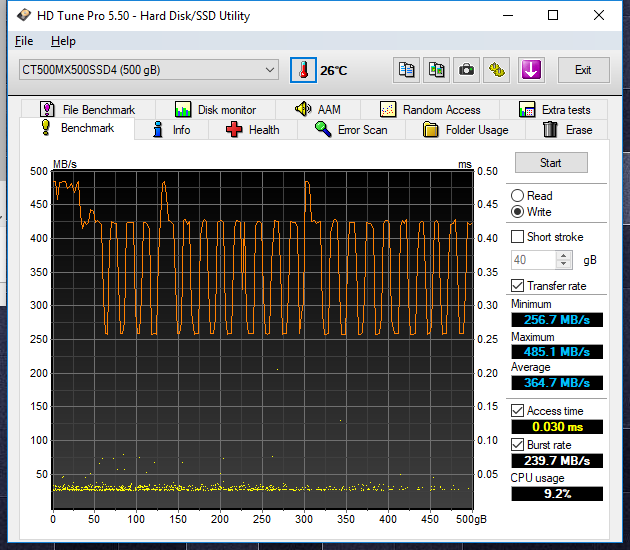HDTUNE
HD Tune is a Hard Disk Utility with many functions from error checking, health testing (S.M.A.R.T.), and of course benchmarking. To build upon our real world write test we also looked to see where the write speeds leveled off to by using HD Tune Pro. If SLC caching is being utilized, this test will typically show it.
Finally, taking a look at how it performs under HDTune’s full write test, we can see that unlike the 1TB 2.5″ model we tested before, the MX500 M.2 model isn’t able to deliver a constant 500MB/s write speed across the capacity. Initially, we thought this was due to the dynamic cache filling, but after taking a look at the controller temperature in CDI, we saw that it was around 70-80°C. Thus, this performance is the result of thermal throttling that kicks in at 70°C.
REPORT ANALYSIS AND FINAL THOUGHTS
While testing our new 500GB MX500 M.2 sample we weren’t expecting to see anything new or anything different in comparison to the 1TB 2.5″ form factor model. Most of the time, performance results are identical from each form factor. During today’s testing that held true, but only for the most part. The 500GB MX500 M.2 did essentially match its 2.5″ brother in performance, reaching 563MB/s read and 525MB/s write. In terms of random IOPS performance, it managed to hit 97K IOPS read in AS SSD and 89K IOPS write in Anvil Storage Utilities. In PCMark 8 its score of 278MB/s was just shy of the 296MB/s the 1TB model hit without the Spectre/Meltdown patch slowing it down. In our real-world testing, it even beat it larger brother, but something happened in HDTune that we weren’t expecting. In HDTune we saw that the M.2 model couldn’t sustain full capacity write performance without thermal throttling. We even had a 120mm fan blowing directly on the drive while testing! A surprising result since the 2.5″ model didn’t have this issue and looking at the PCMark 8 extended results it seems that the M.2’s performance was right where it should be. So, it looks like the stylish front sticker doesn’t provide enough cooling capacity for those of you who are going to be battering your drives with constant non-stop writes, but for anyone else, this really shouldn’t be much of an issue.
FINAL THOUGHTS
With that said, the minor write throttling hasn’t changed our minds about the MX500. Now that it is finally available in an M.2 form factor and now that we have tested it in a 500GB capacity, we can definitely say that it is still one of the best values in the market. Not only is it a good performer, but with an MTBF of 1.8 million hours, improved endurance figures over its predecessor, and now a 5yr warranty, we can see that Crucial is very confident in the MX500’s reliability. The inclusion of its enterprise-class features such as RAIN and power loss protection simply enhance our trust in it as well.
Just as performance and reliability are important, price and looks are too. The MX500’s pricing is very competitive and just like the models before it, the MX500 sets the bar for value. The full coverage sticker on the front, while it may not be the best heat spreader, but it sure is stylish and adds to any new system with a compatible M.2 slot, something not many M.2 drives can do.
After today’s review, we have no hesitations in recommending this SSD. If you are on the lookout for a new SSD, especially something in the M.2 form factor, the MX500 is a great buy. Be sure to…
 The SSD Review The Worlds Dedicated SSD Education and Review Resource |
The SSD Review The Worlds Dedicated SSD Education and Review Resource | 


I know this is an old article, but I’m confused. The trimcheck screenshot literally says, “CONCLUSION: INDETERMINATE.” But the sentence below the screenshot says, “As can be seen in the screenshot above, TRIMcheck’s result is positive.”
Can someone explain this to me?